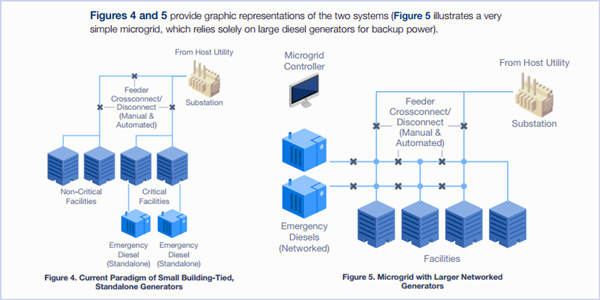By Steve Huntoon
Noblis continues to miss the basic point, which is readily apparent from two figures from its January 2017 report “Power Begins at Home: Assured Energy for U.S. Military Bases” (see graphic). The left figure is the status quo of individual building backup generators. The right figure is a microgrid.
As you can see, the microgrid adds exposure to military base distribution system problems because it is dependent on the distribution system. And distribution system problems cause the vast bulk of outages (87%).
This is not, as Noblis claims, a matter of “correcting” poorly maintained military base distribution systems, which Noblis would do by having the local utility assume responsibility for them.
Problems on local utilities’ own distribution systems cause about the same percentage of their customers’ outages (90%), as documented in footnote 5 of my column. Noblis does not address this.
The point is that most outages have nothing to do with poor maintenance, by military bases or by local utilities. Most outages are caused by severe weather, lightning, human error, unpredictable equipment failure, vehicle collisions, even metallic balloons and squirrels.
If local utilities had magic wands, they would wave them.
Noblis suggests undergrounding distribution systems to mitigate the added risk of microgrids, but it didn’t add the enormous cost of undergrounding to its microgrid costs.[1] And it doesn’t consider that service restoration of an underground line outage typically takes much longer.
Speaking of cost, Noblis says its hypothetical microgrid cost under its natural gas “Case B” is close to the real-world cost of the microgrid at Marine Corps Air Station Miramar. I can’t reconcile this claim with the capital cost data Noblis presents in its Appendix C.2, which appear to be much lower. By the way, even if the Noblis data were right, its Case B is still uneconomic in the Northeast and Southeast regions that it modeled, and only economic in California.
And a few words about cybersecurity. My column did not suggest that no cyber protection exists for microgrids, simply that microgrids add cyber risk (and electromagnetic pulse risk) that does not exist with individual building backup generators.
The Department of Defense cyber protection that Noblis refers to is based on “limiting communication bandwidth within the network [microgrid].”[2] The dilemma is that operating a microgrid of substantial size in parallel, in order to get the peak shaving, energy savings and demand response benefits that Noblis is counting on, cannot be done without communications links with the regional grid operator and the local utility. In other words, you can have (1) high cyber protection through isolation, or (2) benefits of parallel operation, but not both. Noblis eats the cake and has it too.
Finally, Noblis criticizes my reporting that the University of California, San Diego (UCSD) microgrid flunked its acid test in the Southwest Blackout of 2011. Noblis says my reference to that microgrid as “flagship” was “strange at best.” I didn’t make that up — just Google “UCSD microgrid flagship” (without quotation marks).
Steve Huntoon is a former president of the Energy Bar Association, with 30 years of experience advising and representing energy companies and institutions. He received a B.A. in economics and a J.D. from the University of Virginia. He is the principal in Energy Counsel LLP.
(See STAKEHOLDER SOAPBOX – Noblis: Huntoon Microgrid Critique ‘Seriously Flawed’.)
- The Edison Electric Institute estimates that undergrounding a distribution line costs up to $5 million per mile. http://www.eei.org/issuesandpolicy/electricreliability/undergrounding/documents/undergroundreport.pdf (page 31, Table 6.4). ↑
- https://energy.gov/sites/prod/files/2016/03/f30/spiders_final_report.pdf (page 3-15). Microgrid Cyber Security Reference Architecture, which the DOD cyber protection follows (page 3-14), does not consider operational modes in which the microgrid is operating in parallel with the rest of the grid. http://prod.sandia.gov/techlib/access-control.cgi/2013/135472.pdf (page 23). ↑





